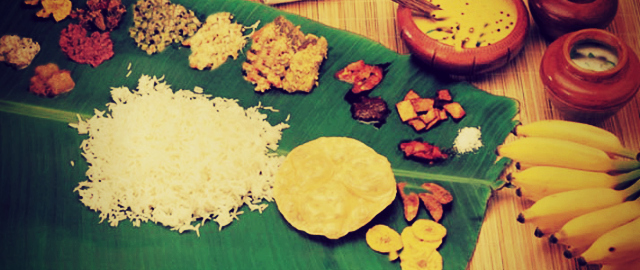
Kerala Food Guide
Kerala’s cuisine is unique, with a blend of spices, coconut and 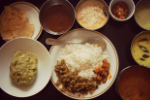 seafood. It has evolved over time, each chapter of its history contributing to its flavors and techniques – ancient Hinduism, the arrival of traders from across the seas and the colonial powers that settled in the state. While there is a thread of similarity running through many of the dishes that are cooked in homes across Kerala, there are three distinct types of cuisine in the state – the vegetarian food of the Hindus, the abundance of meat, poultry and fish in Syrian Christian cuisine and Mapilla food from the Muslim community in North Malabar, which has influences from the Middle East. Together, they present an interesting array of specialties.
seafood. It has evolved over time, each chapter of its history contributing to its flavors and techniques – ancient Hinduism, the arrival of traders from across the seas and the colonial powers that settled in the state. While there is a thread of similarity running through many of the dishes that are cooked in homes across Kerala, there are three distinct types of cuisine in the state – the vegetarian food of the Hindus, the abundance of meat, poultry and fish in Syrian Christian cuisine and Mapilla food from the Muslim community in North Malabar, which has influences from the Middle East. Together, they present an interesting array of specialties.
Hindu vegetarian cuisine
In earlier times, the cuisine of the Hindus of Kerala was strictly 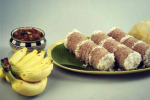 vegetarian, but nowadays, fish and meat are consumed in many homes. Vegetarian cuisine in Kerala has local influences that are unique to the state. Rice is the staple food, but unlike other states, nutritious parboiled rice is consumed instead of raw rice. Tapioca, coconut and banana, which are locally grown, are also used in many dishes. A typical meal consists of rice served with one or two curries (usually dal and coconut based gravy) and a couple of vegetables cooked with grated coconut and spices.
vegetarian, but nowadays, fish and meat are consumed in many homes. Vegetarian cuisine in Kerala has local influences that are unique to the state. Rice is the staple food, but unlike other states, nutritious parboiled rice is consumed instead of raw rice. Tapioca, coconut and banana, which are locally grown, are also used in many dishes. A typical meal consists of rice served with one or two curries (usually dal and coconut based gravy) and a couple of vegetables cooked with grated coconut and spices.
The vegetarian meal has several courses, and this can be experienced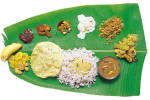 at a traditional sadya (meaning banquet), which is usually served on a plantain leaf during festivals and ceremonies, but is also a popular lunchtime option in many restaurants. The sumptuous meal has unlimited servings of rice with sambar (lentil curry), parippu (dal) and side dishes, which among others include olan (gourd cooked in coconut milk), avial (mixture of vegetables with grated coconut and curd), kaalan (a tuber or raw banana cooked with coconut and curd), pachadi (a side dish of vegetable cooked with coconut, chilies, mustard and curd) and thoren (vegetable sautéed with grated coconut and tempered with mustard). Accompaniments include injipuli (ginger and tamarind chutney), pickle, upperi (banana chips), pappadam, moru (buttermilk) and sharkara upperi (banana chips coated with jaggery and ginger powder). The meal concludes with a sweet dish – payasam (similar to rice pudding). There are several varieties of payasam, including rice, wheat, banana and lentils. Often, jaggery is used instead of sugar, for sweetening the dish.
at a traditional sadya (meaning banquet), which is usually served on a plantain leaf during festivals and ceremonies, but is also a popular lunchtime option in many restaurants. The sumptuous meal has unlimited servings of rice with sambar (lentil curry), parippu (dal) and side dishes, which among others include olan (gourd cooked in coconut milk), avial (mixture of vegetables with grated coconut and curd), kaalan (a tuber or raw banana cooked with coconut and curd), pachadi (a side dish of vegetable cooked with coconut, chilies, mustard and curd) and thoren (vegetable sautéed with grated coconut and tempered with mustard). Accompaniments include injipuli (ginger and tamarind chutney), pickle, upperi (banana chips), pappadam, moru (buttermilk) and sharkara upperi (banana chips coated with jaggery and ginger powder). The meal concludes with a sweet dish – payasam (similar to rice pudding). There are several varieties of payasam, including rice, wheat, banana and lentils. Often, jaggery is used instead of sugar, for sweetening the dish.
Syrian Christian cuisine
The Syrian Christian community comprises the families that were 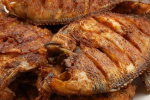 converted to Christianity by St. Thomas, when he arrived in Kerala. Although the flavors of Syrian Christian dishes are more or less similar throughout the state, the ingredients vary. Duck and fish such as Pearl Spot, which are found in the backwaters, are popular in places such as Alleppey and Kottayam. Further north, in Calicut and Cannanore, seafood such as mussels and oysters are used more often.
converted to Christianity by St. Thomas, when he arrived in Kerala. Although the flavors of Syrian Christian dishes are more or less similar throughout the state, the ingredients vary. Duck and fish such as Pearl Spot, which are found in the backwaters, are popular in places such as Alleppey and Kottayam. Further north, in Calicut and Cannanore, seafood such as mussels and oysters are used more often.
Meat dishes are what set apart the Syrian Christian cuisine of Kerala.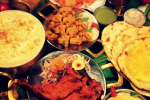 Meat, poultry and seafood preparations using spices such as clove, cinnamon, black pepper and cardamom, give the dishes a burst of flavors. There are a few mildly spiced dishes too. Besides non-vegetarian dishes, breads made from rice powder, such as appam (crisp lacy rice pancakes), iddiappam (thread-like rice noodles) and puttu (steamed rice cake), among others, are well known. Many of these dishes are consumed for breakfast throughout Kerala. They are usually served with a meat curry or gravy.
Meat, poultry and seafood preparations using spices such as clove, cinnamon, black pepper and cardamom, give the dishes a burst of flavors. There are a few mildly spiced dishes too. Besides non-vegetarian dishes, breads made from rice powder, such as appam (crisp lacy rice pancakes), iddiappam (thread-like rice noodles) and puttu (steamed rice cake), among others, are well known. Many of these dishes are consumed for breakfast throughout Kerala. They are usually served with a meat curry or gravy.
Syrian Christian cuisine has several types of meat dishes made using beef, pork, chicken, duck and seafood. The most popular among these are erachi ularthiyathu (spicy fried beef), meen vattichathu (hot and tangy fish curry with red chili powder and kokum), karimeen pollichathu (Pearl Spot fish cooked in a banana leaf with spices and coconut) and tharavu roast (spicy roast duck).
Malabar Muslim or Mappila cuisine
The origin of the Muslim community in Kerala can be traced back to the Arab traders who settled down in the state or married local women. While the ingredients are similar to that of the other communities in the state (especially rice, coconut and spices) there are distinct Arab influences too.
Among the dishes that are unique to mappila cuisine are neichoru 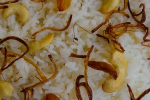 (fragrant fried rice cooked with ghee and spices), pathiri (rice chapatti), mutta mala (translates to egg garland – a lacy sweet dish made from egg yolk) and Alisa (wheat and meat porridge). There are some exotic dishes too such as kozhinirachathu (chicken stuffed with boiled eggs), meen pathiri (steamed rice pancake with fried fish stuffing), unnakai (deep fried dumpling made from boiled and mashed banana stuffed with coconut, raisins, nuts and sugar) and arikadukka (mussels steamed in the shell along with a stuffing of spicy rice mixture, and then fried). The flaky, melt-in-the-mouth Kerala paratha (or porotta) also came to Kerala via the Arabs.
(fragrant fried rice cooked with ghee and spices), pathiri (rice chapatti), mutta mala (translates to egg garland – a lacy sweet dish made from egg yolk) and Alisa (wheat and meat porridge). There are some exotic dishes too such as kozhinirachathu (chicken stuffed with boiled eggs), meen pathiri (steamed rice pancake with fried fish stuffing), unnakai (deep fried dumpling made from boiled and mashed banana stuffed with coconut, raisins, nuts and sugar) and arikadukka (mussels steamed in the shell along with a stuffing of spicy rice mixture, and then fried). The flaky, melt-in-the-mouth Kerala paratha (or porotta) also came to Kerala via the Arabs.
Malabari Biryani is another popular rice and meat dish that is served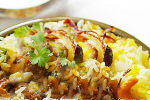 in restaurants in the northern part of the state. It is rich and full of flavor, subtly spiced with green chilies, clove, cardamom, cinnamon, nutmeg, mace, coriander and mint leaves, and cooked using ghee. Biryani is usually made with mutton or chicken, but there are versions with fish and prawn too.
in restaurants in the northern part of the state. It is rich and full of flavor, subtly spiced with green chilies, clove, cardamom, cinnamon, nutmeg, mace, coriander and mint leaves, and cooked using ghee. Biryani is usually made with mutton or chicken, but there are versions with fish and prawn too.
The cuisine of Kerala represents the many cultures that have influenced the way of life of the locals and continue to do so even today. The result is a seemingly endless variety of unusual breakfast dishes and sumptuous lunch and dinner delicacies with exotic flavors, which will tease the palate.


No comments yet.